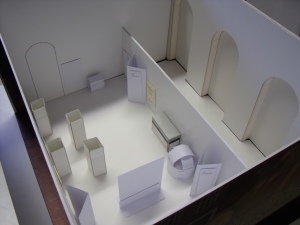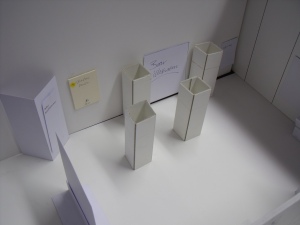After a successful run it was time for the Paul Scott exhibition to move on to its next venue – The Harley Gallery – in order to make way for our new family orientated summer display: Prehistoric People.

Just as when the objects arrived at the Museum, the whole kit and caboodle needed to be condition checked before they left the building. This is to ensure that the condition of them hasn’t changed since installation. The ceramics were then all carefully packed, in the same manner as they had arrived to us.
As soon as everything Paul Scott related was done, we then moved straight on to preparing for the Prehistoric People exhibition.
The first thing was to get the walls from dark blue to natural cream, which had to happen before any of the objects could get placed in the room.

As this is primarily a children’s exhibition the curator decided it would look great to have illustrations on the wall showing what cave drawings were like and how big a life-size bear really is. To do this we commissioned Gateshead artist Liam Murray and we couldn’t have been happier with the results. [To see more of his work click on this link http://www.liammurraydraws.com/]



After getting all the paint work done the object cases need to be put in place. For this we referred to our scale model and plan drawing. Things may not stay exactly the same as the plan, due to reasons such as it doesn’t look right or fit like we thought it would, however it does give us a good initial idea on how the room could look.




Once the cases were in place we could sort out where captions were to be put, along with other design aspects such as panels and vinyl signage. This would also help us decide where the objects would be placed.
The first objects to make their way into the room were from our own collection, and these were soon added to by a few pieces which are on loan from York Museums Trust.
Little odd jobs: Three large pieces from our own collection have to rest on plinths as they are quite heavy and these help spread the weight, but first they have to be painted to match the colour scheme with one requiring a coat of primer first – this cost time. Other small jobs included cutting the size of the Round House so it was able to fit inside its new case and re-covering a small free standing wall for the children to attach their pictures to. Small jobs like these can be time consuming and are often not factored into the planning; so many hands make light work in this instance!

Once all the objects are in, the cases cleaned and levelled, they can now be locked and the finishing touches are ready to be done. Work tables with books, activity packs and colouring pencils, as well as a prehistoric Play Mobil set are all laid out ready for opening. Last minute checks to make sure everything is alright, before taking a well-earned rest after a VERY busy 10 days!
By Charlotte Thresher & Catherine Dickinson, Creative Apprentices